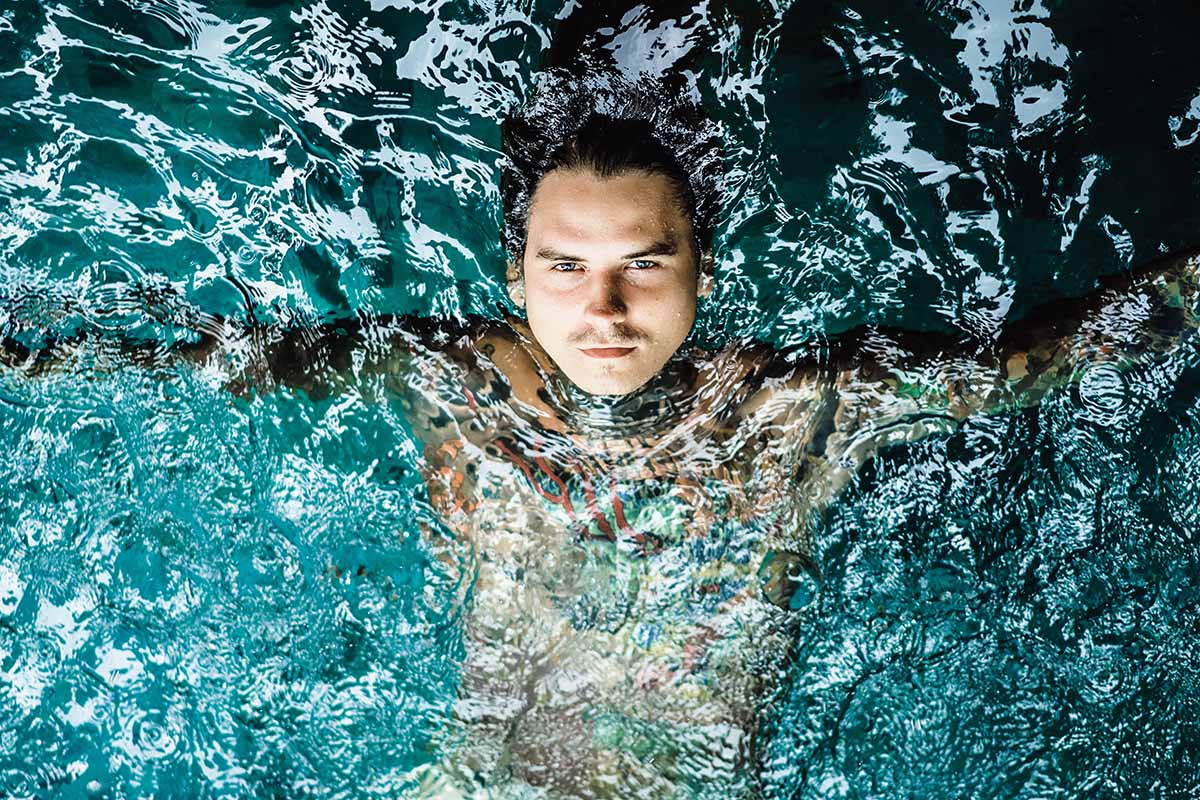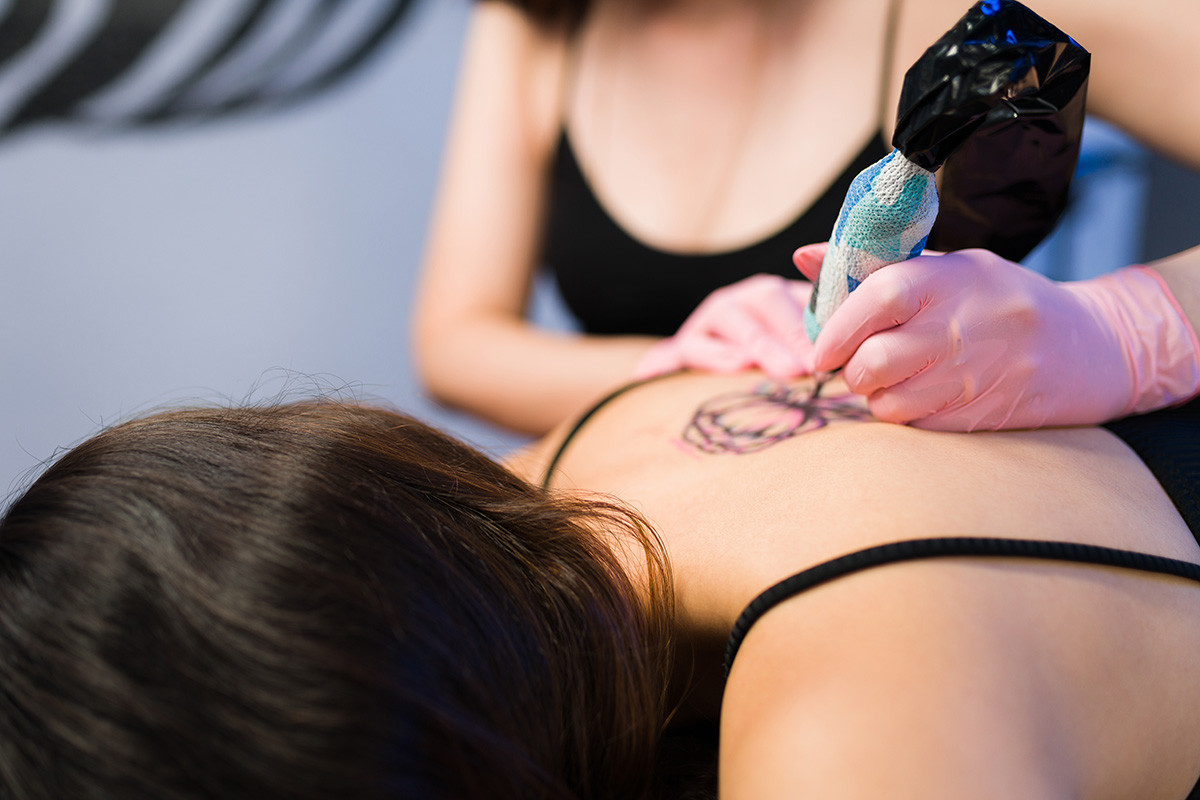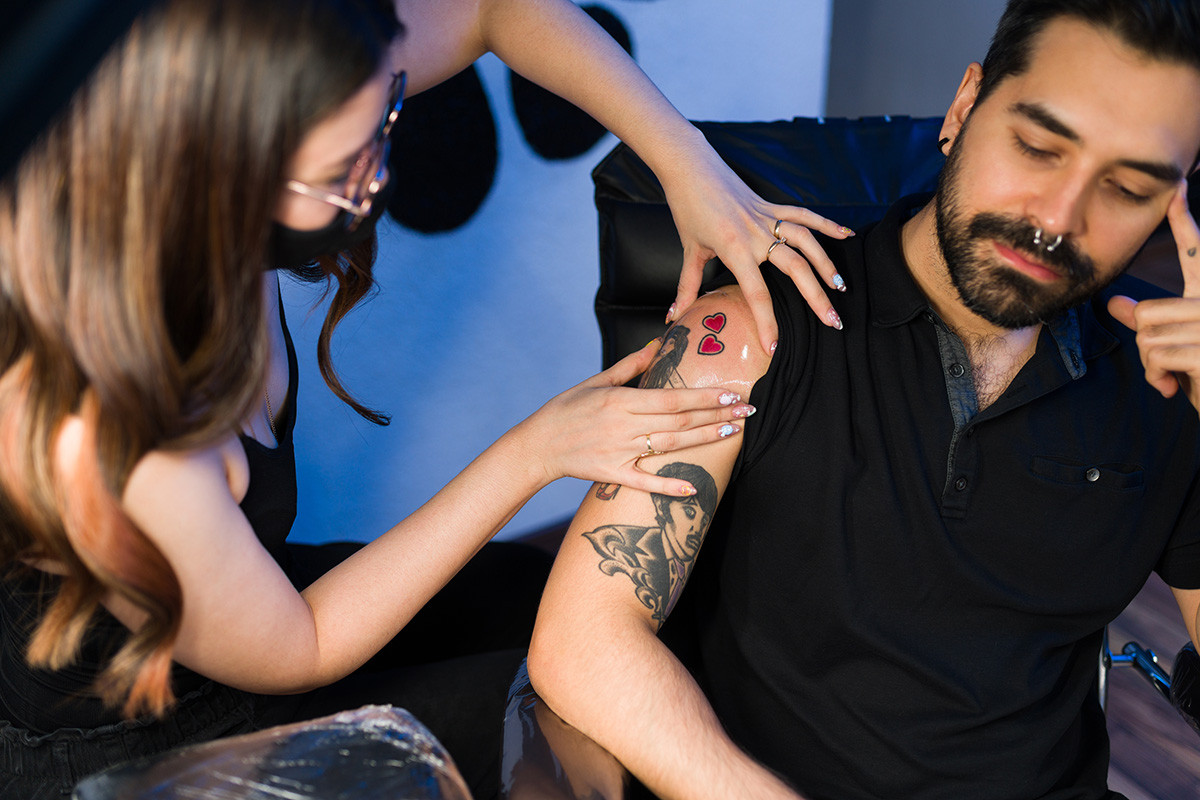Planning a dip in the pool after getting inked? The question, “Can I Swim Before Getting A Tattoo?”, is a common one. At tattooat.com, we understand your eagerness to show off your new body art. But safeguarding your skin and ensuring optimal tattoo healing is paramount. Our comprehensive guide provides crucial insights into tattoo aftercare, potential water-related risks, and how to protect your investment in body art. We will explore suitable healing practices, tattoo protection and artistic expression.
Here’s a detailed exploration of when and how you can safely resume swimming after getting a tattoo!
1. Understanding Tattoo Healing: When Can You Dive In?
 A person getting a new tattoo and the healing process
A person getting a new tattoo and the healing process
Getting a new tattoo is an exciting experience! But remember that proper aftercare is essential for the health and appearance of your newly tattooed skin. Tattoos are essentially open wounds. Exposing them to water too soon can lead to bacterial infections, skin irritation, and even damage to the tattoo design. Therefore, tattoo artists recommend waiting at least 2-4 weeks before submerging your new ink in swimming pools, hot tubs, or open water.
Of course, healing times can vary depending on factors such as the size and location of the tattoo, the individual’s skin type, and the quality of aftercare provided. To ensure the best possible outcome, it’s essential to understand the stages of tattoo healing and the factors affecting healing time.
1.1 The Stages of Tattoo Healing
The tattoo healing process is a fascinating journey that typically includes swelling, pain, and oozing in the first few days. It is followed by itching, peeling, and continued aftercare. Full healing can take anywhere from 2 to 4 weeks or even as long as 6 months for some individuals. During this time, it’s important to avoid swimming and other activities that can irritate the skin and prolong the healing process.
While it may be tempting to take a dip in the pool or ocean during the healing process, it’s crucial to remember that open water carries the greatest risk of bacterial infection. Infections can delay the healing process and even damage your tattoo. So, it’s best to be patient and wait until your tattoo is fully healed before diving in.
1.2 Factors Affecting Healing Time
Several factors can impact the healing time of a tattoo:
| Factor | Description |
|---|---|
| Size of the tattoo | Larger tattoos naturally require more time to heal. |
| Location of the tattoo | Some areas of the body may take longer to heal than others, depending on blood flow and skin thickness. |
| Aftercare | Proper aftercare is vital for reducing healing time and preventing complications like infections or scarring. |
| Individual Skin Type | Some skin types may heal slower than others. |
It’s essential to monitor the healing process closely. Consult your tattoo artist if you have any concerns about the progress of your tattoo’s healing before diving into the water.
2. Risks of Swimming with a Fresh Tattoo
Swimming with a fresh tattoo can expose your new artwork to a whole host of potential issues. Water can dry out the skin, leading to increased itching, flaking, and scabbing – not exactly a fun experience. These issues can also cause fading, patchiness, and blurred lines in your fresh ink, which is definitely not the desired outcome when it comes to fresh tattoos.
Aside from the physical discomfort and potential damage to your tattoo, swimming with a fresh tattoo can also increase the risk of bacterial infections. Pools, lakes, and oceans are teeming with bacteria. Your healing tattoo is an open wound that’s susceptible to these invaders. To protect your tattoo and ensure a smooth healing process, it’s best to avoid swimming until your tattoo is fully healed.
2.1 Bacterial Infections and Open Wounds
Since tattoos involve breaking the skin and introducing a foreign substance (ink) into the body, they are considered open wounds. When you submerge your healing tattoo in water, you potentially expose it to harmful bacteria lurking in pools, lakes, and oceans. This can lead to irritation, infection, and other complications that can harm your tattoo and prolong the healing process.
To minimize the risk of bacterial infections, it’s essential to keep your new tattoo clean and protected from water exposure. Waterproof dressings and bandages can help shield your tattoo from bacteria and other contaminants while swimming. Remember, it’s always better to be safe than sorry when it comes to your tattoo’s health.
2.2 Chlorine and Salt Water Effects
Chlorine and salt water can have negative effects on your fresh tattoo. Exposure to these elements can cause:
- Irritation
- Fading
- Discoloration
- Leaching of the ink from your tattoo
Even if you’re swimming in a chlorinated pool, it’s important to remember that chlorine doesn’t kill all bacteria and can still pose a risk to your healing tattoo.
In addition to the potential irritation and fading caused by chlorine and salt water, both can have a drying effect on the skin. This can exacerbate any existing irritation and prolong the healing process. To ensure your tattoo heals properly and maintains its vibrant appearance, it’s best to avoid swimming until your tattoo is fully healed.
3. Protecting Your New Tattoo While Swimming
 A person protecting their new tattoo while swimming with waterproof dressings and bandages
A person protecting their new tattoo while swimming with waterproof dressings and bandages
If you absolutely must swim before your tattoo is fully healed, there are some precautions you can take to protect your new ink. While it’s not ideal, using waterproof dressings and bandages can help shield your tattoo from water and bacteria while swimming. Just be sure to remove the dressing immediately after swimming and clean your tattoo thoroughly to minimize the risk of infection.
Remember, swimming with a fresh tattoo is not recommended. Taking these precautions does not guarantee that your tattoo will be safe from infection or damage. It’s always best to wait until your tattoo is fully healed before submerging it in water, but if you must swim, be sure to take the necessary steps to protect your artwork.
3.1 Waterproof Dressings and Bandages
Waterproof dressings and bandages can be a lifesaver if you need to swim with a new, fresh tattoo. These special coverings are designed to provide a barrier between your wet tattoo and the water, helping to keep your new ink safe from bacteria and other contaminants.
Some of the best waterproof dressings for a new tattoo include:
- Saniderm Tattoo Aftercare Bandage, a popular waterproof dressing
- Recovery Derm Shield Tattoo Aftercare Bandage
- Tattoo Aftercare Waterproof Bandage
- Nexcare Tattoo Bandages
- Nuanchu Waterproof Bandage
Be sure to apply the dressing before swimming and remove it immediately afterward. Change it regularly to ensure your tattoo remains protected.
3.2 Post-Swim Care
After swimming, it’s essential to clean and care for your tattoo to minimize the risk of infection and damage. Here’s what you should do:
- Gently wash the tattoo with warm water and a mild, fragrance-free soap.
- Pat the area dry with a clean towel.
- Apply a thin layer of a fragrance-free moisturizer to keep the skin hydrated and promote healing.
Remember, post-swim care is crucial to maintaining the health and appearance of your tattoo. By taking the necessary steps to protect your new ink, you can help ensure a smooth healing process and enjoy your beautiful tattoo for years to come.
4. What are the signs that your tattoo is ready for swimming?
Once your tattoo has fully healed, you can safely enjoy swimming without worrying about potential damage or infection. But how can you tell when your tattoo healed and is ready for a dip in the pool or ocean? Some key signs your tattoo is fully healed include the absence of redness, itching, scabbing, or flaking, as well as a smooth, even appearance without any peeling.
If you’re unsure whether your tattoo is fully healed, it’s always best to consult your tattoo artist or a medical professional before taking the plunge. They can assess your tattoo’s healing progress and provide guidance on when it’s safe to dive in.
4.1 Visual Indicators
Visual indicators can help you determine whether your tattoo is ready for swimming. Look for signs such as no bubbling or degradation, no redness or peeling, and a smooth, even appearance without any flaking or scabbing. If your tattoo meets these criteria, it’s likely healed and safe to expose to water.
Keep in mind that everyone’s healing process is different. It’s essential to monitor your tattoo closely throughout the healing process. If you have any concerns or notice any unusual symptoms, contact your tattoo artist or a medical professional for advice.
4.2 Consulting Your Tattoo Artist
Your tattoo artist is an invaluable resource when it comes to determining whether your tattoo is ready for swimming. They have extensive experience with the healing process and can assess your tattoo’s progress, providing expert guidance on when it’s safe to expose your ink to water.
If you’re unsure whether your tattoo is fully healed, don’t hesitate to swing by the studio where you had your tattoo done and let a professional check it for you. It’s always better to err on the side of caution and ensure your tattoo is fully healed before diving into the water.
5. Alternative Water Activities During the Tattoo Healing Period
 A person enjoying alternative water activities during the tattoo healing period
A person enjoying alternative water activities during the tattoo healing period
If you’re dying to get in the water while your tattoo is healing but don’t want to risk damaging your new ink, there are some alternative water activities you can engage in. Instead of swimming, consider taking gentle showers and avoiding direct water jets. Boiling tap water for cleansing is another option to minimize the risk of infection.
Remember, it’s essential to keep your new tattoo clean and protected from water exposure during the healing process. By choosing alternative water activities, you can still enjoy the water while ensuring your tattoo heals properly and looks its best.
6. Can you go in hot tubs, saunas, and other water hazards with fresh tattoo?
Hot tubs and saunas may be relaxing, but they can pose significant risks to your new tattoo if you indulge too soon after getting inked. The warm, moist environment in hot tubs and saunas can increase the risk of bacterial infections and hinder the healing process of your tattoo. It’s recommended to wait at least 3-4 weeks after getting a tattoo before entering a hot tub or sauna.
By avoiding hot tubs, saunas, and other water-based environments during the healing process, you can protect your new tattoo and ensure it heals properly. Once your tattoo is fully healed, you can enjoy all your favorite water activities without worry.
7. Expert Insights on Tattoo Aftercare and Swimming
We consulted with renowned tattoo artist Anya Savelova, known for her intricate designs and dedication to client education. Savelova emphasizes, “The first few weeks are critical. Think of your tattoo as an open wound. Would you expose an open wound to a public pool? Probably not.” She further advises, “Even after the initial healing phase, prolonged soaking can draw ink from the tattoo, especially with vibrant colors.” This expert opinion underscores the importance of diligent aftercare and avoiding prolonged water exposure.
According to research from Portland State University’s Art Department, in July 2025, maintaining proper hydration and a healthy lifestyle can significantly aid the tattoo healing process. Staying hydrated keeps the skin supple, which helps the tattoo heal evenly and quickly. A balanced diet rich in vitamins and minerals provides the necessary nutrients for skin repair and regeneration, further supporting the healing process.
8. Finding Inspiration and Artists at tattooat.com
At tattooat.com, we understand that getting a tattoo is a significant decision. It’s not just about the art; it’s about expressing yourself and finding the right artist to bring your vision to life.
That’s why we offer a comprehensive platform where you can:
- Discover stunning tattoo designs: Browse thousands of unique designs across various styles, themes, and placements to find the perfect inspiration for your next tattoo.
- Connect with talented artists: Explore profiles of skilled tattoo artists from around the USA, view their portfolios, and find an artist whose style resonates with you.
- Learn about tattoo aftercare: Access in-depth articles and guides on tattoo aftercare to ensure your tattoo heals beautifully and remains vibrant for years to come.
Whether you’re a seasoned tattoo enthusiast or a first-timer, tattooat.com is your go-to resource for all things tattoos. We’re committed to providing you with the knowledge, inspiration, and connections you need to make informed decisions and enjoy the art of tattooing to the fullest.
Address: 1825 SW Broadway, Portland, OR 97201, United States
Phone: +1 (503) 725-3000
Website: tattooat.com
9. Dive Deeper into Tattoo Culture and Trends
The world of tattooing is constantly evolving, with new styles, techniques, and trends emerging all the time. At tattooat.com, we stay on top of the latest developments to bring you the most relevant and up-to-date information.
Here are some of the hottest tattoo trends in the USA right now:
- Fine Line Tattoos: Delicate and intricate designs created with ultra-thin needles, perfect for minimalist and elegant tattoos.
- Watercolor Tattoos: Soft, dreamy tattoos that mimic the look of watercolor paintings, using vibrant colors and blurred edges.
- Geometric Tattoos: Bold and symmetrical designs featuring geometric shapes, lines, and patterns, often incorporating dotwork and shading.
- Blackwork Tattoos: Striking tattoos that use only black ink to create bold, graphic designs, often inspired by tribal art and traditional tattooing.
- Illustrative Tattoos: Detailed and realistic tattoos that resemble illustrations, often featuring animals, nature scenes, or portraits.
10. Can I Swim Before Getting A Tattoo: FAQs
10.1 What happens if you swim while your tattoo is healing?
Swimming with a new tattoo can be dangerous, exposing your wounded skin to bacteria in the water that can cause infections ranging from mild to severe. It can also irritate the skin, resulting in major itching, oozing blisters, and hives. Avoid swimming entirely while your tattoo is healing to protect it.
10.2 Can I swim 7 days after tattoo?
It is advised to wait for your tattoo to fully heal, which can take at least two to four weeks before swimming in any kind of water. Going into the pool or ocean before then may put you at risk of infection due to bacteria or germs that can enter an open wound.
10.3 How long after tattoo can you swim in chlorine?
Wait at least two weeks and up to four to six weeks after getting a tattoo before swimming in chlorine-filled water. Don’t risk infection by going into the pool or hot tub too early!
10.4 Can I use waterproof dressings to protect my tattoo while swimming?
Yes, you can use waterproof dressings to protect your tattoo while swimming – just make sure it’s fully healed before you do!
10.5 What are the risks of swimming with a fresh tattoo?
Swimming with a fresh tattoo carries the risk of bacterial infections, skin irritation, and damage to the design, so it is best avoided for the first few weeks after getting a new tattoo. It is important to take the necessary precautions to ensure that your tattoo heals properly and looks its best. Taking the time to wait before swimming can help you avoid any potential problems.
10.6 How to clean a new tattoo?
To properly clean a new tattoo, start by washing your hands thoroughly. Gently wash the tattoo with warm water and a mild, fragrance-free soap, using your fingertips to create a lather. Rinse the area thoroughly and pat it dry with a clean paper towel. Avoid using a cloth towel, as it may harbor bacteria.
10.7 How to protect tattoo from sun?
Protect your tattoo from the sun by applying a broad-spectrum sunscreen with an SPF of 30 or higher. Apply the sunscreen liberally at least 15 minutes before sun exposure and reapply every two hours, or more often if swimming or sweating. You can also cover your tattoo with clothing or seek shade during peak sun hours.
10.8 How long does a tattoo take to heal?
The initial healing stage of a tattoo typically takes 2-4 weeks, during which the outer layers of skin heal. However, complete healing, including the deeper layers of skin, can take several months. Factors such as the size and location of the tattoo, your overall health, and how well you follow aftercare instructions can affect the healing time.
10.9 What is tattoo aftercare?
Tattoo aftercare involves keeping the tattoo clean and moisturized to prevent infection and promote healing. This includes washing the tattoo with mild soap and water, applying a thin layer of tattoo-friendly moisturizer, and protecting the tattoo from the sun. Avoid picking or scratching the tattoo, and wear loose-fitting clothing to prevent irritation.
10.10 What do tattoo infections look like?
Signs of a tattoo infection include excessive redness, swelling, pain, or pus-like drainage from the tattoo site. The area may feel warm to the touch, and you may develop a fever. If you suspect a tattoo infection, seek medical attention immediately.
Summary
Understanding the healing process of tattoos and the risks associated with swimming too soon after getting inked is crucial for protecting your new artwork. By following proper aftercare guidelines, using waterproof dressings and bandages when necessary, and waiting until your tattoo is fully healed before submerging it in water, you can help ensure a smooth healing process and maintain the vibrant appearance of your tattoo.
Whether you’re a seasoned ink enthusiast or a first-time tattoo recipient, it’s essential to prioritize the health and safety of your new tattoo. So, before you dive into the water, make sure your tattoo is ready for a swim – and remember, patience pays off when it comes to preserving the beauty of your ink!
Ready to explore the world of tattoos? Visit tattooat.com today to discover stunning designs, connect with talented artists, and learn everything you need to know about tattoo aftercare!
